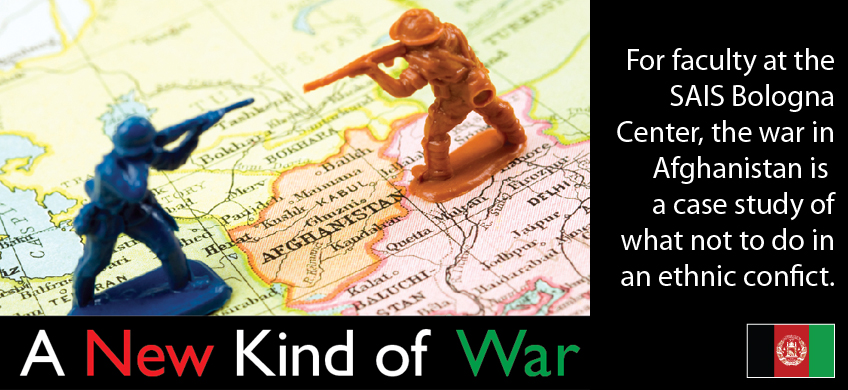
Nearly a decade after the United States thought it had toppled the bad guys in Afghanistan, American military and government officials are still dealing with warlords, jihadists, drug traffickers, and extortionists. And those are just the Americans’ Afghan allies. A rampantly corrupt government still does not exert political control over much of the country. The Taliban have stepped back into that vacuum, and their resurgence has prompted many ethnic Afghan militias to rearm. A long sequence of miscalculations has left the United States with seemingly nothing but bad options for years to come.
Welcome to the future, says Erik Jones, SAIS Bol ’89 (Dipl), SAIS ’90, ’96 (PhD), professor at the Nitze School of Advanced International Studies’ Bologna Center. Afghanistan is not alone as a place where tensions among ethnic, tribal, and religious groups can erupt into chaos, and often do. The kind of war the United States and NATO have been fighting in Afghanistan may be typical of those the world will face in the 21st century.
Jones and some of his Bologna Center colleagues have been working for more than a year to implement a new ethnic conflict studies initiative. Funded by Jack Wasserman, SAIS Bol ’64 (Cert), his wife, Carol, and the Wendy’s/Arby’s Group Foundation, the initiative aims at understanding how ethnic factors figure into what international affairs experts say is the present face of war—intrastate conflicts that involve a collapse of civil society and mass mobilization of ethnic groups. Writing in the International Journal on World Peace, Muzaffer Ercan Yilmaz of Balikesir University in Turkey noted that from May 1988, when the Cold War was ending, to 2007, the United Nations intervened in 44 intrastate conflicts.
“Many of today’s conflicts have origins in tribal or religious differences,” says Kenneth Keller, Engr ’63 (MSE), ’64 (PhD), director of the Bologna Center. “We’re looking at what causes these differences to grow into conflicts, to what extent can one generalize about causes, and how escalation might be avoided.”
Global powers like the United States need to approach these wars first by grasping new realities. “Traditional wars involved state-to-state conflict,” Jones says. “[Now] we’re less concerned with state-to-state conflict than we are with the hostilities and violence that grow out of failed states.”
SAIS faculty who analyze various aspects of these conflicts believe that Afghanistan offers a case study in what not to do when searching for a peaceful solution to intrastate conflict. The United States and its NATO allies, they argue, bungled the effort from start to finish—supporting corrupt and reviled warlords, paying scant attention to building the rule of law, undermining an international peacekeeping effort, closing their eyes to Pakistani support for the Taliban, and failing to pay attention to hidden economies that can make the prolongation of warfare serve the financial interests of some of the antagonists. “Now [the allies] haven’t a clue about what to do there,” says Francesc Vendrell, an adjunct professor of international relations who teaches conflict mediation and dispute resolution at the Bologna Center. Vendrell is a former personal representative of the United Nations secretary-general, as well as a former special representative of the European Union for Afghanistan.
The first mistake, Vendrell argues, was backing the wrong people. In 2000 and 2001, he was a U.N. envoy seeking a peaceful resolution to the civil war then battering Afghanistan. U.N. Secretary-General Kofi Annan had charged Vendrell with doing what he could to end the violence between the fundamentalist Taliban, who had taken control of much of the country in 1996, and the Northern Alliance, a loose coalition of defiant ethnic groups, including Hazaras, Uzbeks, Turkmen, and Tajiks, that controlled some areas of Afghanistan’s northeast provinces. Pre-Taliban, these groups had fought among themselves in what amounted to gang wars for land and drug profits. But opposition to the Taliban had, at least for a time, united them.
As part of his effort, Vendrell cultivated the Northern Alliance’s leader, Ahmad Shah Massoud. Massoud, a Tajik, was called the “Lion of Panjshir” for his fierce resistance to the Soviet army that occupied Afghanistan in the 1980s. He was one Afghan leader that the West felt it could work with. He had attended secondary school in France, studied engineering at Kabul Polytechnic, and served for a time in Kabul as Afghanistan’s defense minister in the first post-Soviet government, which was dominated by Tajiks. After the Taliban, mostly Pathans and hard-line Islamists, seized control of the capital and most of the country in 1996, Massoud fled to the Panjshir Valley but expressed a willingness to work with the Taliban to create a settlement. Vendrell, as the U.N. envoy, hoped a peaceful solution might emerge.
